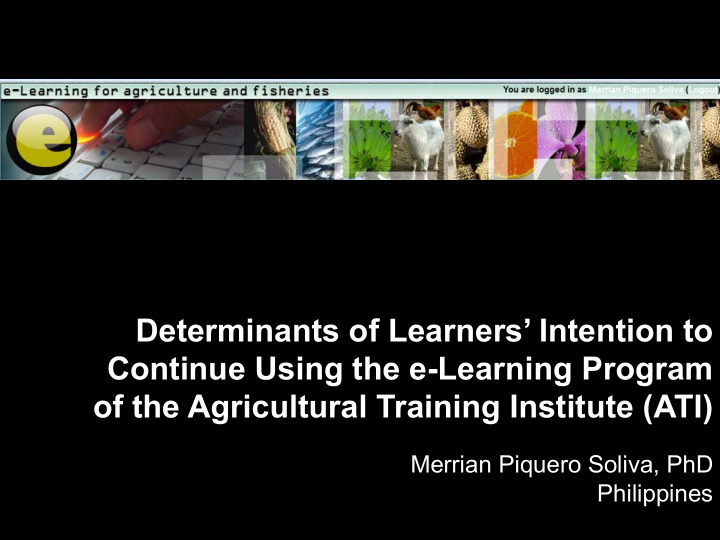



Determinants of Learners’ Intention to Continue Using the e-Learning Program of the Agricultural Training Institute (ATI) Merrian Piquero Soliva, PhD Philippines
Research Objectives Specific General investigate the 1. Determine the socio-demographic profile of the learners of the influence of the ATI’s e-Learning for agriculture and fishery program in the learners’ attitude, Philippines; 2. Assess their e-Learning experience; the perceived 3. Find out the learners’ attitude towards the e-Learning program, satisfaction and their perceived satisfaction and perceptions of the perceived effectiveness of the program; e-Learning 4. Determine the relationship between the learners’ attitude towards the program, the perceived satisfaction of the program effectiveness and the perceived effectiveness of the program, and their intention to continue using the e-Learning program. 5. Identify the strengths and challenges of the e-Learning program. ¡ ¡
Theoretical Framework
Conceptual Framework e-learners Inten%on ¡to ¡ • Attitude towards the con%nue ¡using ¡ ¡ ATI’s e-learning ATI’s ¡e-‑Learning ¡ program • Perceived Program ¡for ¡ Effectiveness of the Agriculture ¡and ¡ program • Perceived Fishery ¡in ¡the ¡ Satisfaction of the Philippines ¡ program
Research Methods and Data Sources 2. Focus group 3. ATI-Central Office 1. Instruments and discussion data base data sheets § selected • List of enrolees and • Online questionnaire e-Learners graduates covering • Printed § Agricultural 2009-2012 with questionnaire extension workers complete contact • FGD transcriptions § Students details (email; phone § 16 ATI Regional numbers and house Training Centers address) nationwide 960 respondents (both enrolees and graduates from 2009-2012)
The SITUATION: ATI’s e-Learning § Online certificate • Crops course • Livestock and § Digital learning poultry resources • Marine and § e-Extension coordinator as regional fisheries administrator • Organic § Started 2007 agriculture § 10,000 registered • Social users § 6,000 graduates technologies § 33 online courses
Socio-Demographics 4. Educational 5. Respondents 1. Sex Attainment • 67.9% Agricultural • 58.9% Females • 56% College Extension Workers Graduates • 14.2% In-school 2. Status • 28.4% Post Graduate youth • 66.1% Married • 10.4% College Level • 17.9% others (agriculture advocate, • 4.8% High School farmer, government • .3% Vocational employee, self-employed; 3. Age farmers, OSY, housewife, • From 16 to 63 range; retirees, OFW, private mean is 36 years emoployees)
e-Learning Experience From scale of 1 - NO EXPERIENCE 2 - LESS EXPERIENCE 3 - FAIR EXPERIENCED 4 - EXPERIENCED 5 - WELL EXPERIENCED Mean ¡Ra%ng: ¡ 1.0-‑1.4999 ¡= ¡1 ¡No ¡Experience ¡ ¡ ¡3.5-‑4.4999 ¡= ¡4 ¡Experienced ¡ 1.5-‑2.4999 ¡= ¡2 ¡Less ¡Experienced ¡ ¡4.5-‑5.0 ¡ ¡ ¡ ¡= ¡5 ¡Well ¡Experienced ¡ 2.5-‑3.4999 ¡= ¡3 ¡Fairly ¡Experienced ¡
From scale of 1 - NO EXPERIENCE 2 - LESS EXPERIENCE 3 - FAIR EXPERIENCED Mean ¡Ra%ng: ¡ 4 - EXPERIENCED 5 - WELL EXPERIENCED 1.0-‑1.4999 ¡= ¡1 ¡Strongly ¡Disagree ¡ ¡ ¡ 1.5-‑2.4999 ¡= ¡2 ¡Disagree ¡ ¡ ¡ ¡ 2.5-‑3.4999 ¡= ¡3 ¡Neutral ¡ 3.5-‑4.4999 ¡= ¡4 ¡Agree ¡ 4.5-‑5.0 ¡ ¡ ¡ ¡ ¡= ¡Strongly ¡Agree ¡
Learners’ Attitude System ¡Stability ¡
Learners’ Attitude Courselab ¡Sa%sfac%on ¡
Learners’ Attitude Mul%-‑Media ¡Instruc%on ¡
Learners’ Attitude e-‑Learning ¡System ¡Quality ¡ ¡
Learners’ Attitude Interac%ve ¡learning ¡ac%vi%es ¡ ¡
Perceived Satisfaction Self-‑efficacy ¡
Perceived Satisfaction e-‑Learning ¡effec%veness ¡
Intention to continue using
Strengths and Challenges Extent ¡of ¡influence ¡on ¡par%cipa%on ¡
Strengths and Challenges Extent ¡of ¡influence ¡on ¡implementa%on ¡
Conclusions 1. Most ¡of ¡the ¡adult-‑learners ¡are ¡in ¡the ¡middle-‑age ¡category ¡and ¡are ¡ college ¡graduates, ¡married ¡and ¡agricultural ¡extension ¡workers ¡and ¡ generally ¡have ¡a ¡fair ¡experience ¡with ¡e-‑Learning. ¡ ¡ 2. The ¡ATI’s ¡e-‑Learning ¡program ¡is ¡well-‑established, ¡secured ¡and ¡ stable. ¡In ¡its ¡en%rety, ¡the ¡respondents ¡are ¡sa%sfied ¡with ¡the ¡course ¡ lab ¡used ¡by ¡ATI. ¡ ¡ 3. The ¡respondents ¡prefer ¡to ¡use ¡a ¡mul%-‑media ¡instruc%on ¡program. ¡ The ¡adult-‑learners ¡have ¡recognized ¡that ¡the ¡e-‑Learning ¡system ¡ quality ¡of ¡the ¡program ¡is ¡important ¡as ¡well ¡as ¡the ¡interac%ve ¡ learning ¡ac%vi%es. ¡
Conclusions 4. Opera%ng ¡the ¡e-‑Learning ¡system ¡of ¡ATI ¡can ¡boost ¡self-‑efficacy/ confidence ¡of ¡extension ¡workers. ¡The ¡e-‑Learning ¡program ¡is ¡ effec%ve ¡because ¡it ¡assists ¡them ¡in ¡their ¡learning ¡efficiency, ¡ performance ¡and ¡mo%va%on. ¡ 5. The ¡adult-‑learners ¡intend ¡to ¡con%nue ¡the ¡use ¡of ¡the ¡ATI’s ¡e-‑Learning ¡program ¡ because ¡they ¡can ¡access ¡a ¡wide ¡array ¡of ¡free ¡digital ¡resources. ¡Consistent ¡with ¡ FGD ¡results ¡where ¡learner’s ¡said ¡that: ¡ “I ¡intend ¡to ¡conFnue ¡with ¡e-‑learning ¡for ¡it ¡ gave ¡me ¡saFsfacFon ¡whenever ¡I ¡see ¡my ¡grades; ¡the ¡knowledge ¡I ¡gained, ¡and ¡the ¡ mulFmedia ¡presentaFon ¡is ¡enjoyable,” ¡quoted ¡by ¡a ¡student-‑learner. ¡ Moreover, ¡ an ¡agricultural ¡extension ¡worker-‑learner ¡said ¡that: ¡ “Agriculture ¡is ¡a ¡very ¡dynamic ¡ field. ¡I ¡need ¡to ¡update ¡my ¡know-‑how ¡in ¡my ¡field.” ¡
DAGHANG ¡SALAMAT! ¡ THANK ¡YOU! ¡
Recommend
More recommend